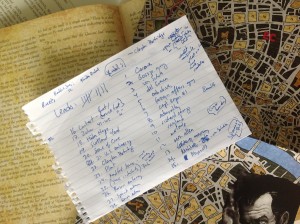
[The notes from our first case, along with the casebook and map]
Why? This is part of our cooperative boardgames kick. It can’t all be Robinson Crusoe, and the $120 sticker price has delayed our purchase of Mice & Mystics. Plus, I was aware of this game when I was a kid and so have always been curious how it worked, as I love mysteries.
How did it go? The game comes with ten mysteries, which are real original stories and not something like Clue or Scotland Yard. You visit different locations, which correspond to different parts in a puzzle book. You’ve got a map of London that provides the keys for the casebook, along with a newspaper that has some pertinent details (and many red herrings).
We had fun working together to solve the mystery, which was more difficult than either of us were expecting. We did figure it out in the end. The game has to involve an entirely nonlinear story since it can’t know what order you are going to reveal the clues (beyond controlling when particular names or places are revealed). The game was originally written in the early 1980’s, I think, and it could mostly be done now as a hypertext game on a computer, which would have some advantages from a story perspective. But, of course, we wouldn’t likely sit there are read together to do it if it was just hyper-text, and having to actually look up the leads invoked more thought about which lead to follow up next than mindless clicking.
Would you do it again? Yes. I don’t know if we’ll get through all ten mysteries, but it was entertaining enough certainly to give another go.
